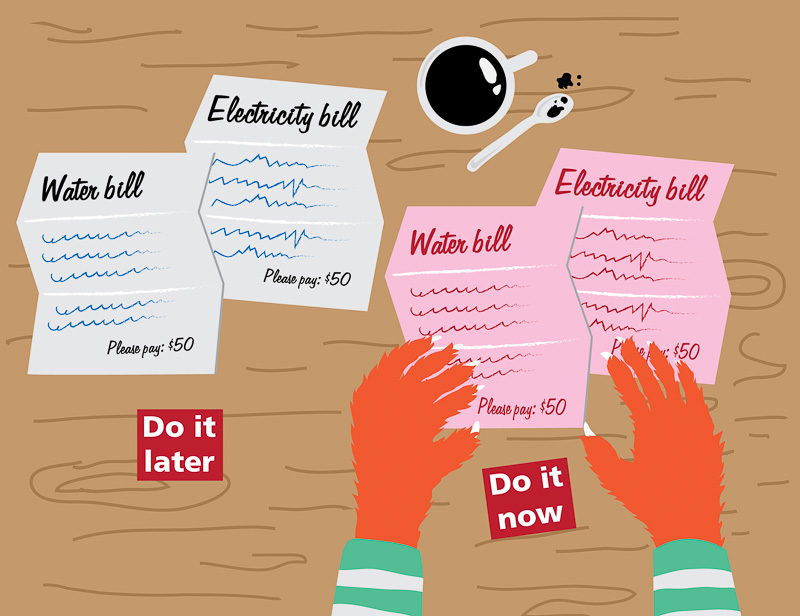Policy Making Tip: Nudge, Not Shove

The Ministry of Manpower (MOM) has also realised the power of pink to get people moving in the right direction. In a trial, sending pink reminder letters instead of the usual white to employers of foreign domestic workers who defaulted on paying levies had prodded more of them to make payment in response (see side story ‘It pays to make BIg steps’ below). It seemed that the employers felt compelled to pay up because the colour reminded them of late reminders sent by phone and utilities companies.

Here’s another scenario: A person looks at the back of his Singapore Power (SP) bill and, seeing that his electricity and water usage exceeds that of the average Singaporean, strives to be less wasteful.
The above two instances may seem unrelated, but they are actually examples of the use of Behavioural Insights (BI) to subtly influence us to do the “right” thing. BI is based on behavioural economics, which combines psychology with economics and assumes that people don’t always make the best choice – contrary to the assumption of traditional economics that people make rational decisions.
It pays to make BIg steps

MOM’s BI team (from left): Ms Chew Ee Tien, Ms Teo Ya Chih and Ms Wong Hefen.
The Behavioural Insights and Design Unit at MOM was newly set up to apply BI to improve the design and delivery of MOM’s policies and programmes, and gain a deeper understanding of customer behaviour, said Deputy Secretary (Manpower) Augustin Lee.
“The use of BI enables a systematic and evidence based method to strengthen internal processes and communications to enhance the overall customer experience,” he added.
“We want to develop a culture of testing and experimentation in MOM where officers seek to understand customers and do rapid prototyping via RCTs before full-scale implementation, where possible,” Assistant Director Chew Ee Tien said.
“We have also conducted many workshops to build capabilities in understanding customer motivation and behaviour, as well as in running RCTs among our officers.”
One of their first initiatives was an RCT, conducted by MOM’s Work Pass Division and the Central Provident Fund Board, to nudge employers of foreign domestic workers to make timely levy payments. Some employers default and MOM will send them a letter to remind them to pay. Half of the 1,000 people in the trial received the usual monthly letter on white paper. The other half received a letter printed on pink paper, with a simplified layout and important information made clearer. For example, the outstanding amount is in bold. “Mobile and utilities companies often print their late letter notices on pink paper. As such, the colour reinforces the message that payment is late,” said Ms Chew.
The letter also included a statement about the social norm that 96% of employers pay the levy on time. She said the result was a 3-5% improvement in response rate when they sent the pink letter. MOM is now considering the implementation of the new letter.
Beyond the trials, Ms Chew added, “We hope that in the longer term we can help officers... develop a mindset of experimentation and willingness to test their hypothesis before deciding whether it will work.”

Rather than setting policies assuming that people will always make the best choices, using BI to find out how people actually make decisions can reveal otherwise. With this knowledge, policymakers can create messages using BI methods that nudge people into acting in the public interest.
For instance, the graphs on SP bills use the insight that people follow social norms, so they’ll use less water if they know that’s what other people do. Similarly, people may exercise more or eat more healthily if they know others are doing the same thing. Another method relies on the role of inertia in decision-making: in organ donation programmes or optional retirement savings plans, if people are automatically enrolled rather than having to opt in, the greater will be support for the scheme.
Pushing 'em gently
Around the world, governments are finding that using BI to persuade people is easier, cheaper and more effective than using fines and stern warnings.
The UK’s Revenue & Customs, for example, found that a message saying “9 out of 10 people in Exeter pay their taxes on time”, nudged an extra 15% of late taxpayers to follow the social norm and pay taxes earlier. The “Clean Love to Copenhagen” campaign that put green footprints leading to rubbish bins on the streets reduced litter by 46% as residents followed a nudge that spotlighted good social behaviour. And in the education sector, teachers in French schools use different names for technical drawing after a study found that boys do better if the subject is called “geometry” while girls do equally well or better if it is called “drawing”.
With results like these showing the value of BI, many governments have started to set up BI units to nudge people to-wards making better decisions.
Perhaps the best-known is the Behavioural Insights Team (BIT) in the UK, also called the Nudge Unit, which was set up soon after David Cameron became prime minister in 2010. BIT works with almost every government department as well as non-profit organisations, companies and even foreign governments. It helps ministries with everything from reducing late tax payments and improving training policies, to evaluating whether advice or a subsidy can nudge businesses to grow faster. “If you have a more intelligent, nuanced account of how people make decisions, you can design policy that is more effective, less costly, and makes life easier for most citizens,” BIT Director David Halpern told The Telegraph. The Market Research Society (MRS), a leading global association for market research professionals, reported that BIT has already saved 22 times its cost.
In Denmark, rather than setting up a government unit, Roskilde University and the University of Southern Denmark created a “INudgeYou” team to bring public institutions, non-governmental organisations (NGOs) and private stakeholders together to develop strategies for “closing the gap between pro-social intentions and actions”. Along with reducing litter, INudgeYou has worked on projects such as prompting for a choice for organ donation in order to increase participation.

Singapore inches towards BI
While BI is still in the early stages in Singapore, ministries are starting to use it more. “We don’t have a centralised agency organising it,” said Professor Ho Teck Hua, a BI expert and Vice President for research strategy at the National University of Singapore. Instead, BI is “independent bottoms up,” with ministries launching their own BI projects and initiating nudges on their own.
The CSC has been encouraging public officers to use BI. It published Behavioural Economics and Policy Design – Examples from Singapore in 2012 to help policymakers understand BI better, and it runs forums to educate public officers. Ministries, including Finance, and Environment and Water Resources (MEWR), have started their own nudge initiatives (see side story 'BI to the rescue' below).
At the Inland Revenue Authority of Singapore, for example, a study found that using an SMS reminder increased the percentage of people who paid overdue property taxes before a penalty was imposed from 16% to 47%. And after a study showed that convenience will help people recycle more, MEWR will make recycling easier for households by giving them small recycling boxes.

While there is plenty to learn from other countries, Prof Ho also told Challengeit is important to consider the local situation rather than just adopting practices from overseas: “In the Asian context, peer influence plays a stronger role; it (Singapore) is a more conforming society than Western countries. The other thing that is different is people here tend to respect authority a bit more.”
The reasons for using BI in Singapore may be different from elsewhere too. CSC Director of Public Economics Dr Thia Jang Ping said that while the UK may use it to reduce government expenditures, the focus here is more to enhance social safety nets sustainably (by encouraging the adoption of healthy habits, for example), spur more volunteerism and philanthropy, or promote gracious social behaviours.
BI to the rescue

MEWR officers use BI for policy formation (from left): Ms Ng Wee Hia, Mr Jason Boh, Ms Deborah Lee and Mr Christopher Tan.
MEWR officers use BI for policy formation (from left): Ms Ng Wee Hia, Mr Jason Boh, Ms Deborah Lee and Mr Christopher Tan.
MEWR may have been using BI longer than other ministries. “The National Environment Agency (NEA) adopted parts of it in outreach programmes in dengue campaigns in 2009 and 2010,” said Deputy Director of the Environmental Policy Division Christopher Tan. In 2012, MEWR formed the Environmental Behavioural Sciences & Economics Research Unit to derive behavioural insights for policy formation.
The unit works with other officers in MEWR, NEA and PUB, the National Water Agency, on projects to use economic concepts in environmental and water policies. It also offers internal sharing sessions to raise awareness of BI.
MEWR has completed studies on household recycling and energy efficiency, said Senior Assistant Director Ng Wee Hia. For household recycling, the study showed that the main motivator is intrinsic – people recycle because they feel good about contributing to the environment and convenience will help them to recycle more. Using those insights, the NEA is producing small cardboard recycling boxes for households to conveniently separate their recyclables from general waste.
For energy, motivations to save electricity are extrinsic and a different approach is needed to show people how they can save money.
Mr Tan said they mainly use two tools for their analysis. One is surveys and focus groups. The other is policy experiments, which can identify some things surveys can’t tell you, since people often are not aware of their cognitive biases.
The team is working with the ministry and statutory boards to think of interventions, design experiments, incorporate control groups and design good statistical analysis.
“There is a wealth of things that can be done to nudge people for more environmentally friendly behaviour,” Mr Tan said. “With BI, we are trying to think about them harder.”
- POSTED ON
Jan 15, 2014
- TEXT BY
Richard Hartung
- ILLUSTRATION BY
Mushroomhead
-
Deep Dive
Strengthening Singapore’s Food Security









